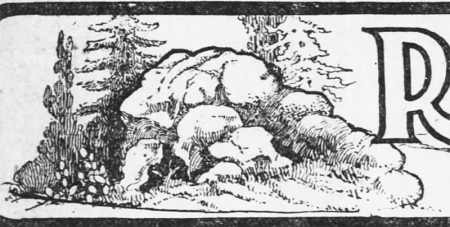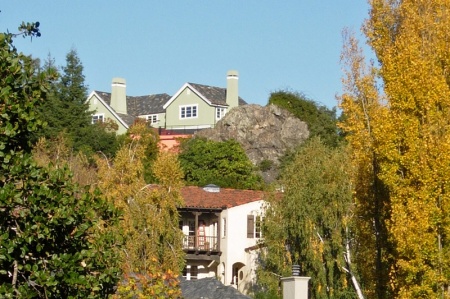I led a walk around the headwaters of Lion Creek this weekend, visiting the Lincoln Square serpentine and landslide, the Alma Mine and Crusher Quarry sites, and the Hayward fault over at 39th Avenue (one of the seven stations). One of the best parts of the trip was revisiting the creek at McCrea Memorial Park and Oakland’s casting pools, an unsung civic amenity for our fly-fishing population.
The casting pools were constructed in the late 1950s. The land was part of the city’s Leona Park, which extended from here across Mountain Boulevard and up Horseshoe Creek. To all appearances, this site was a natural floodplain at the time, bare of vegetation. They did a beautiful job, and a fringe of trees was planted around the pools that soon provided the atmosphere of seclusion that still prevails. The next stage of developing the area was to build a set of ponds downstream where you could fish for actual trout, not just practice flycasting.
The trout ponds were a city concession, managed by a caretaker from the little house across the creek. Barratt Wells, a Piedmont native who also operated a trout pond in Tilden Park, was awarded the ten-year contract in 1959, but he died in 1963.
There were three ponds, stocked with trout each year. The Oakland Tribune reported, “One pond contains fish from six inches up and is for use by children over five and non-expert adults. A second pond is for toddlers under five, while the third, with a completely natural setting, is for the experts, who will fish for trout up to three pounds.” You paid for what you caught.
When the route 13 freeway was pushed through in the 1960s, it split the park into two pieces, Leona Heights Park on the east and this part, named George E. McCrea Memorial Park in 1962, on the west. An obscure pedestrian overcrossing connecting the two parcels is the route we took.
(George McCrea owned this land, and his son gave it to the city. He also owned a historic bit of land farther north by Holy Names College, where he had a house. More about that in a bit.)
The fishing program ended around 1975, and the ponds soon filled with silt. Police volunteers mucked them out in the summer of 1981, and the state supplied the park with trout. The police association ran popular fishing sessions for kids there every summer through at least 2009.
The 1960-era design was pretty good at fitting three working ponds in the narrow space available. Here’s how it looked in the spring of 2014, the first time I came here.
First of all, everything is concrete, even the creek bed itself running along the right side. The wall in the front has two cutouts, the big one on the right and a little one on the left. Timbers and steel plates are inserted over these gaps to regulate the flow through them, and the space in the front is the first trout pond. The second pond is just past the redwood tree (which was planted ca. 1960) and the third one, much larger, is behind it. Here’s another view that shows the little cutout better.
It all looks tidy in these views, but the ponds held stagnant, weedy water at the time and a pair of ducks.
This weekend, nine years later, the lowest pond looked like this (view upstream).
Nice enough. Peaceful. But no good for trout. And here’s the uphill side again. The middle pond isn’t even a pond any more.
I had so forgotten the middle pond that I was enthusing to the group about the lovely wetland being watered with this ingenious system. I regret the error. And in the front you can see that the first pond is filling up with sediment too, not to mention the creek bed behind it.
Lion Creek is not a major watercourse, yet you can see how dynamic streambeds are. To build and maintain a park in one is an expensive, ongoing project, and I think the city should consider how to let this picturesque ruin-in-the-making find its way back to a state that’s easier to manage. The casting pools will be okay for many years to come.
Back to George McCrae. His land up by Holy Names was the Ohlones’ old ocher mine, and the chair-sized boulders placed around the trout ponds look to be the same stuff. They don’t look the same because they’ve acquired a shaggy coat of lichens in the moist environment, but they’re bright red inside. Admire them too when you visit.
A final treat in McCrea Park is up near the entrance.
These sandstone blocks are pieces of Oakland’s first high school, built in 1871. I’ve documented them on Lakeshore Avenue and near Lake Merritt, and it’s always a pleasure to find them.











